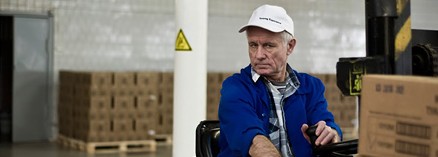Implementation project for the ‘LM execution’
warehouse management system of the Svoboda cosmetic company

Warehouse processes and products in storage
|
|

 Main warehouse inventory item groups
Main warehouse inventory item groups
- Solid, liquid and inert raw materials used for the manufacture of packaging materials
- Glass containers
- Labels, stickers and other printed goods used for product packaging purposes
- Finished products
Main objectives, problem statement
- Existing WMS only partially controls the acceptance of finished products from the production lines and the traffic between warehouse facilitie.
- Employees report using paper documents instead of RF terminals, i.e. the record keeping system receives data with a significant delay.
- The record keeping system does not contain information on the shelf lives of the goods stored. Expired products are monitored manually by the warehouse employee.
- Both control over the required turnover and selection of commodities with required shelf lives for the order are need attendance resulting in frequent errors and delays.
- The incorrectly projected commodity flows within the warehouse complex result in lots of excessive handling operations consuming much human power.
- The goods subject to laboratory analysis are “blocked” by means of their isolated storage in a dedicated zone, with special identification labels, which means additional handling and resources consumed
WMS requirements
- Intuitive, user-friendly interface
- The record keeping system does not contain information on the shelf lives of the goods stored. Expired products are monitored manually by the warehouse employee
- Adapted for various types and categories of products: finished goods, raw materials, packaging, containers, etc.
- Given the company’s stringent quality control of the incoming raw materials and finished products, the system should support different product availability statuses
- The transfer of components to the production lines and the receipt of ready products from the production lines should be managed by the system
- When moving goods from one warehouse facility to another, the system should generate multi-step tasks: storage cell to source warehouse shipping area, from there to destination warehouse receipt area, from there to destination warehouse cell storage
- Order picking by pallets, boxes and piece managed by the system
- All warehousing operations must be performed using RF terminals
- An option to take some of the stock for shipment subject to the Customer’s residual shelf life requirements

TLS solution
- In-depth review of the warehouse structure, warehousing operations, internal commodity flows, commodity exchange principles. Allowance for specific features of goods storage and handling operations, analysis of the Customer’s wishes to check their implementability in the system. Proposals to optimize warehousing processes, simulation analysis of the future solution.
- Recommendations for changing the business processes of the warehouse logistics, the functional responsibility of employees, the topology of the warehouse facilities.
- Implementation of the LMexecution warehouse management system delivered by TLS’s partner a-SIS.
- Configuration of integration with the Customer’s accounting system.
- Uploading of initial data and reference information into the system.
- Setup of the manufacturing order processing method: calculate the number of components required, transfer the raw materials to the production lines, accept the finished products from the production lines.
- Optimization of the order picking process by setting up special box and piece selection zones, ensuring the compliance with the product shelf life restrictions in these zones.
- Configuration of a buffer storage area in the order picking warehouse where the system controls the availability of goods and automatically generates tasks to replenish the stock from other warehouses of the complex as necessary.
Result

- The Customer in now in a position to monitor stock balances in terms of storage cells, product status, or shelf life.
- The use of RF terminals ensures reliable real-time information on all the warehousing operations.
- The data exchange between the WMS and ERP systems has improved the teamwork of the Customer’s inter-related departments: the accounting office receives reliable operational data, the purchasing office controls the existing stock without additional resources.
- Optimization of goods handling operations inside and between the warehouses has boosted the overall performance, resulting in lower expenses for warehousing operations.
- Much fewer picking errors.
- Keeping records of all the operations in the system has made it possible to control the employees’ performance, to optimize the allocation of resources between the facilities.